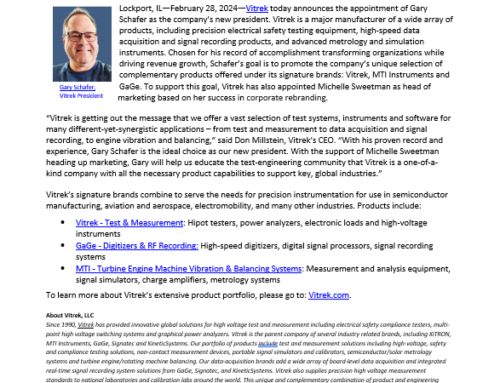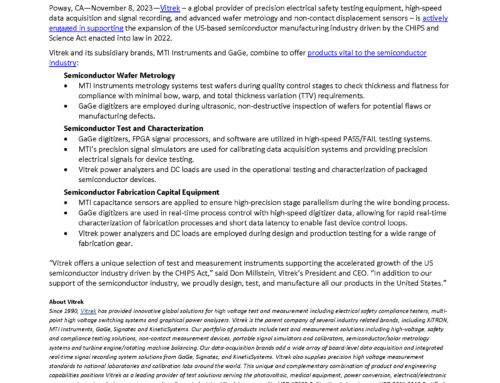Vitrek is proud to hold educational webinars for our customers in various industries with information and products that are relevant to their applications. One such industry that relies on some of the technology that we offer is the appliance and consumer products industry, which requires extensive electrical safety testing in order to bring their products to market. All products that will be sold to consumers need to be tested by a Nationally Recognized Testing Laboratory (NRTL) in order to earn the proper safety certification.
Vitrek’s Chad Clark, Vice President of Sales, hosted an in-depth webinar on this topic, which is summarized below.
Hipot and Ground Bond Testing for Consumer Products and Appliances
Consumer products and appliances which use electricity fall into three categories:
- Class I: basic insulation, often have a metal chassis. Must include a protective ground (earth) to reduce the risk of shock. 3-pin input receptacle.
- Class II: double or reinforced insulation eliminates the need for a protective ground (earth). Often have a non-metal chassis. 2-pin input receptacle.
- Class III: Receives power from a separated, extra low voltage (SELV) power source. Under normal conditions, the voltage is low enough that there is virtually no risk of electrical shock.
Class I and II products need to undergo rigorous testing under high voltages to ensure that they are safe for use. Hipot (short for “high potential voltage”) testers are one way that these products are tested. Another important electrical test is ground bond testing, which verifies that all conductive parts exposed to the user are connected to the ground (earth).
Vitrek’s Electrical Testing Products for Consumer Products and Appliances
Vitrek has a number of offerings to help customers in this industry to accurately and efficiently test their products, including:

Each offering within a series offers numerous options and configurations to meet an organization’s testing requirements as well as their budget.
General Guidelines for Choosing AC or DC Testing
The general guideline for choosing AC or DC for product testing is simple: if the product is AC, use AC; if the product is DC, use DC. However, there are a few instances where testing with the opposite may be the preferred method. For example, for some high-capacity products, it may be beneficial to test the peak of the AC using DC. This might be a good option if a high percentage of the current is leakage, helping to uncover manufacturing defects.
Types of Testing Failures
If a product fails an electrical test, it may fail in one of the following ways:
- Leakage: some leakage is normal, but if it exceeds a certain limit, it is considered a fail
- Breakdown: rapid increase in current through insulation
- Arcing: rapid increase in current through insulator; sometimes see or hear the arc or flash, rapidly self-extinguishes
- Corona: caused by ionization of air around sharp points at high voltages
Adjusting settings on the testing unit will help you find the best compromise of quality while meeting the standards for safety.
Employee and User Safety
Sometimes, employees may show trepidation when working with electrical testing equipment. Since these products do use high voltages, ensuring that everyone is well-versed in the proper safety procedures for working with them is critical. There are several ways to make working with electrical testing products safer, including the use of switches, but for optimal safety, Vitrek recommends the use of safety enclosures.
The Importance of Recordkeeping and QT Enterprise Software
When performing electrical safety testing on products, keeping a written record is vital. It helps to maintain product quality by showing if there have been any changes over time, such as more leakage. It can also show if there were any changes in the product due to switching suppliers, and can provide traceability if someone has an issue with the product later and you need to prove that there were no faults.
The webinar can be viewed in its entirety here. Our entire library of past webinars and other educational videos is also available on our site.
Contact Vitrek Today
For more information on Vitrek’s products available for the appliance consumer products industry, reach out to us today.


